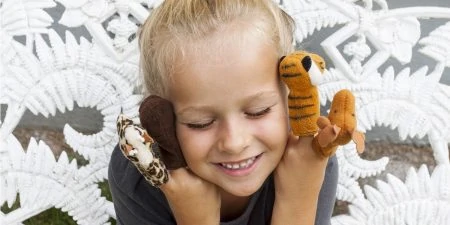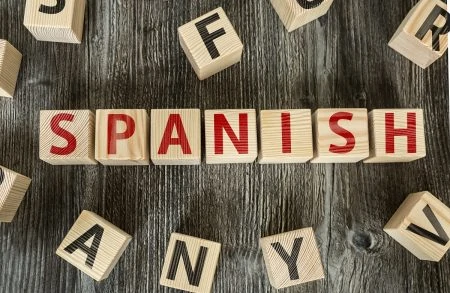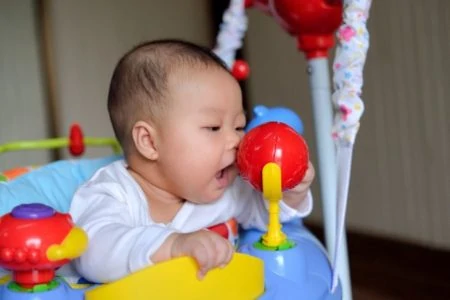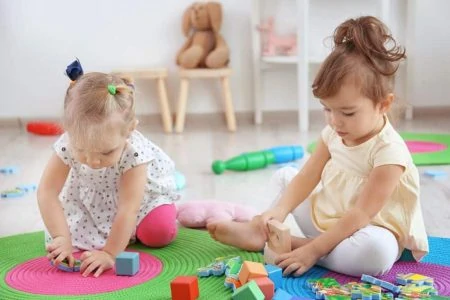Fingerplay is an easy, no-cost way to play with your child, build language, and prep them for preschool. If you’re not sure what fingerplay is or how to start, this quick guide will help. Try a few short songs and movements, then pick the ones your child loves.
Key Takeaways
- Fingerplay pairs hand movements with songs, rhymes, or short stories to build motor skills and rhythm.
- It improves language, memory, imagination, and social skills through repetition and multisensory play.
- Start with short, familiar rhymes and simple actions; repeat often to boost learning and confidence.
What Is Fingerplay?
Fingerplay is when hand and finger movements match a song, rhyme, or short story. Movements can be big, like waving, or small, like wiggling a finger tip.
It’s simple: you say or sing a line and do an action. Kids copy the action, which helps motor control, rhythm, and memory.
Why Is Fingerplay Important for Kids?
Fingerplay helps development in several practical ways:
- Oral Language Skills: Repeating songs and rhymes strengthens mouth muscles and vocabulary.
- Imagination: Actions help children picture characters and scenes, which supports storytelling.
- Brain Development: Memorizing patterns and sequences supports memory and attention.
- Social Skills: Sharing fingerplays with peers builds turn-taking and group confidence.
- Engagement: The multisensory nature of fingerplay makes it great for kids who need low-pressure interaction.
- Understanding New Concepts: Songs can teach counting, colors, opposites, body parts, and sequence.
Since kids can copy the actions without knowing every word, fingerplay works across ages, languages, and abilities.
How To Start With Fingerplay
Keep sessions short and fun. Aim for 1–3 minutes for toddlers and up to 5 minutes for older preschoolers. Use songs your child already knows, and repeat the same few each week. Start with one action and add more as they get confident.
Try these tips:
- Choose Familiar Tunes: Use nursery rhymes you already sing together so the child focuses on actions.
- Model Slowly: Do the action once, then let the child try; praise attempts, not perfection.
- Use Props Sparingly: Felt pieces, finger puppets, or paper cutouts can help, but avoid tiny parts that are choking hazards.
- Repeat Often: Repetition builds mastery and makes the activity comforting.
Tips For Inclusive And Bilingual Play
Fingerplay adapts well for different needs and languages. Use larger motions for kids with limited fine motor skills. Swap in sign language or simplified gestures if a child has speech delays. To support bilingual children, sing the same fingerplay in both languages—this strengthens vocabulary and cross-language connections.
25 Fingerplays for Preschoolers
We compiled these popular, easy-to-teach fingerplay ideas you can try at home or in class.
1. 5 Little Donuts
Five Little Donuts works with felt or paper cutouts. It’s great for kids who prefer moving objects to fine finger folding.
2. One Little Finger
Sing this in two languages to support bilingual development and make finger names stick.
3. Baby Bumble Bees
No fine-motor skills needed—this one focuses on rhythm and fun sound effects.
4. Baby Shark
A modern classic. Kids share songs like this easily at preschool, which boosts social connection.
5. Climbing Caterpillar
Use finger “legs” to climb an imaginary tree. Props are optional.
6. Finger Faces
Draw expressions on fingers and name feelings. Pause and let your child guess the emotion.
7. Five Little Leaves
Stick colored leaves to fingers for counting and color practice.
8. Five Fingers
A fun way to teach finger names like thumb, pointer, and ring.
9. Walking Animals
Use felt animals to “walk” across a hand while singing Old MacDonald or another tune.
10. Peanut Butter and Jelly
Mix gross and fine motor moves; use this as a transition into snack or lunch time.
11. Here Is The Beehive
Good for learning movement words and finger isolation.
12. Twinkle Twinkle Little Star
A familiar melody makes it easier for kids who struggle with new actions.
13. Ants On A Tree
Easy movements and a playful surprise at the end keep kids engaged.
14. Open, Shut Them
Great for transitions—use to calm down or to wake up the group.
15. Multi-Story Gloves
Make or buy gloves with characters to cover many songs without extra prep.
16. Mary Had A Little Lamb
Focus on simple rhythm and hand-eye coordination if a child finds actions tricky.
17. Ten Little Friends
Counting fingerplays that help kids learn numerals and sequence.
18. London Bridge Is Falling Down
Simple patterns are less stressful for shy or anxious children.
19. Mr. Wiggle and Mr. Waggle
Use repetitive storytelling with finger actions to build memory and laughter.
20. Opposites
Teach concepts like loud/soft and big/small through contrasting actions.
21. Mr. Thumbkin
Body-part songs are interactive and let you build anticipation with pauses.
22. Fuzzy Little Caterpillar
Introduce life cycles with a simple action sequence: caterpillar, chrysalis, butterfly.
23. Hickory Dickory Dock
Pair with a paper clock to practice counting and early time concepts.
24. Chubby Little Snowman
Let kids choose animals or props to encourage creativity.
25. Five Little Pumpkins
Any two-syllable object works. This rhyme adapts well to cultural or seasonal variations.
Extensions And Safety Notes
Try these quick extensions and keep safety in mind:
- Extension Activities: Turn fingerplays into counting games, story prompts, or simple crafts to deepen learning.
- Safety: Avoid small props for children under 3. Supervise finger puppets and glued or sewn pieces.
- Progression: Move from large arm motions to finer finger isolation as kids develop hand strength and coordination.
FAQs
Multisensory Learning
Fingerplay is an adaptable, inclusive way to connect and teach through movement, sound, and repetition. Use it for quick transitions, to boost language, or as a playful break. Start small, repeat the favorites, and follow your child’s lead.







